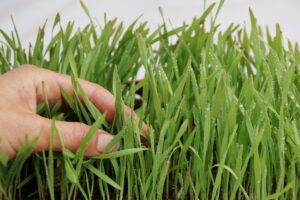Planting a lawn from seed is a great way to get your backyard looking its very best. Not only is sowing seed the least expensive way to get yourself a new lawn, it is also accompanied by a sense of pride and accomplishment that you just can’t get from installing roll-out turf.
While you’ll need patience when growing grass from seed, the process itself is actually a very simple one. Let’s walk through the steps required to make your lawn the most patch vibrant it can be!
When to Plant
The ideal time of year to plant your seed is just before the grass’s peak growing season. This will give it a kick-start in life, allowing it to quickly establish itself and be ready for use as soon as possible.
Grasses are either cool-season or warm-season, and their peak growing periods will reflect their climate preference.
Warm season grasses, as you might’ve guessed, love the warmer weather, and will do best if planted in late spring. This gives them a chance to establish when the weather isn’t debilitatingly hot, but will have them enjoying and capitalising on the hotter weather over summer.
Cool season grasses, on the other hand, are quite partial to cooler weather. Planting them in late summer/early autumn will give them a nice warm soil to germinate in, but allow them to enjoy the entire autumn/winter cool period and properly establish themselves while conditions suit.
Preparation
To get your backyard ready for sowing, you’ll need to prepare the soil so it is the perfect home for the new seed tenants. It may be as simple as tilling and levelling out the soil so your lawn grows flat, but if you’re unsure of the quality of your soil you may also want to do a PH test (available at any good nursery – you’re aiming for a neutral PH of 7) to ensure your seed will germinate and thrive. A starter fertiliser is a great addition to your soil to get it to its most nutritious.
If you’re using a watering system it will be ideally installed before you sow your seed.
Sowing Your Seed
You’ve got two options when it comes to sowing seed. By using a spreader you will get the most even coverage, but for smaller areas hand sowing may be just as effective, without the need to hire equipment.
If you use a spreader, ensure it is set to the appropriate spreading rate for your chosen seed (measure in grams per square metre), and start by putting only half of your seed in the machine. Roll over your soil in one direction, then roll over the soil in the opposite direction with the other half of the seed. This ensures a nice, even dispersion.
Hand sowing is obviously a far less exact science, and you may require the help of a scale so you can recognise how much seed you require for a certain area. If your seed requires 20g/m2, measure out 20g and familiarise yourself with how big it feels in your hand, then use that as a base of how much to spread per square metre.
If your area is prone to over-friendly bird life or intense storms, a light spread of organic matter may be required to protect the freshly sown seeds.
You’ll then want to lightly roll (or walk over) the whole area, ensuring the seeds are in good contact with the soil. This also stops the seeds being blown away by a stiff breeze.
Post Sowing
The first water of the area may well be the most important step in the entire process. You want to properly soak the soil, wetting down to 15-20cm below the surface, but without creating puddles or disturbing the seeds. This means spraying the area with a mist rather than a stream, and you may find yourself needing to do it in 2-3 shifts to get the soil wet enough.
From there, you’ll need to ensure the soil stays nicely moist until the point of germination (usually a couple of weeks later). A good rule to remember is to go by the colour of the soil. If the soil is two thirds lighter than when you’ve freshly watered it, it’s time to water again.
Protecting and Caring for Your New Lawn
You need to keep kids and pets off the lawn until it is properly established. Use a temporary fence to ensure it remains untouched.
As your lawn germinates and grows, your watering routine can ease off. Depending on the variety of grass, you could wind back to anything from a once-a-day routine to a no-watering-at-all routine.
Your first mow should occur when your lawn reaches 8-10cm, and it is a nice idea to follow the first mow with a dose of quality fertiliser. A new lawn is a hungry lawn, and will appreciate the meal.
It’s as Easy as That!
Your new seeded lawn is just a few simple steps away – what are you waiting for?
If you’ve got any lawn seeding questions, or want to know what lawn variety would be best for your situation, contact your nearest McKays seed specialist today!



